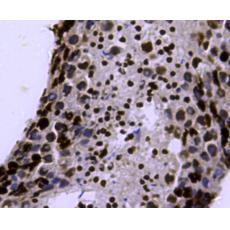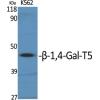-

专业包装 正品保证
-

快乐服务 售后无忧
-

会员特权 优惠不断
-

个人信息 严格保护
| 别名: | Di-mehtyl-Histone H3(Lys4) | ||
|---|---|---|---|
| 适用物种: | Human, Mouse, Rat | ||
| 验证应用: | WB,ICC,IHC-P,FC | ||
| 种属: | 兔多抗 | ||
| 储存条件: | -20℃ | ||

|
| 货号 | 规格 | 可用库存 | 销售价(RMB) | 您的折扣价(RMB) | 购买数量 |
|---|
| 熔点: | |
|---|---|
| 密度: | |
| 储存条件: | -20℃ |
Anti-Di-mehtyl-Histone H3(Lys4) antibody
种属反应性Human,Mouse,Rat
验证应用WB,ICC,IHC-P,FC
抗体类型兔多抗
免疫原Synthetic peptide of the N terminal residues of Human Di-mehtyl-Histone H3(Lys4).
偶联Non-conjugated
形态Liquid
浓度1 mg/mL.
存放说明Store at +4℃ after thawing. Aliquot store at -20℃. Avoid repeated freeze / thaw cycles.
存储缓冲液1*PBS (pH7.4), 0.2% BSA, 40% Glycerol. Preservative: 0.05% Sodium Azide.
亚型IgG
纯化方式Peptide affinity purified.
亚细胞定位Nucleus.
其它名称
Histone H3/a
Histone H3/b
Histone H3/c
WB:1:1,000
ICC:1:50-1:200
IHC-P:1:50-1:200
FC:1:50-1:100

Fig1: Western blot analysis of Di-mehtyl-Histone H3(Lys4) on different lysates. Proteins were transferred to a PVDF membrane and blocked with 5% BSA in PBS for 1 hour at room temperature. The primary antibody was used at a 1:1,000 dilution in 5% BSA at room temperature for 2 hours. Goat Anti-Rabbit IgG - HRP Secondary Antibody (HA1001) at 1:5,000 dilution was used for 1 hour at room temperature.
Positive control:
Lane 1: Human liver tissue lysate, untreated
Lane 2: Histone lysate, purified from 293T
Lane 3: F9 cell lysate, untreated
Lane 4: F9 cell lysate, treated with Histone H3 peptide-unmodifed
Lane 5: F9 cell lysate, treated with Histone H3 peptide-di-methyl K4

Fig2: ICC staining Di-mehtyl-Histone H3(Lys4) in Ags cells (green). Formalin fixed cells were permeabilized with 0.1% Triton X-100 in TBS for 10 minutes at room temperature and blocked with 1% Blocker BSA for 15 minutes at room temperature. Cells were probed with the antibody (R1110-3) at a dilution of 1:200 for 1 hour at room temperature, washed with PBS. Alexa Fluorc™ 488 Goat anti-Rabbit IgG was used as the secondary antibody at 1/100 dilution. The nuclear counter stain is DAPI (blue).

Fig3: ICC staining Di-mehtyl-Histone H3(Lys4) in Hela cells (green). Formalin fixed cells were permeabilized with 0.1% Triton X-100 in TBS for 10 minutes at room temperature and blocked with 1% Blocker BSA for 15 minutes at room temperature. Cells were probed with the antibody (R1110-3) at a dilution of 1:200 for 1 hour at room temperature, washed with PBS. Alexa Fluorc™ 488 Goat anti-Rabbit IgG was used as the secondary antibody at 1/100 dilution. The nuclear counter stain is DAPI (blue).

Fig4: ICC staining Di-mehtyl-Histone H3(Lys4) in HepG2 cells (green). Formalin fixed cells were permeabilized with 0.1% Triton X-100 in TBS for 10 minutes at room temperature and blocked with 1% Blocker BSA for 15 minutes at room temperature. Cells were probed with the antibody (R1110-3) at a dilution of 1:200 for 1 hour at room temperature, washed with PBS. Alexa Fluorc™ 488 Goat anti-Rabbit IgG was used as the secondary antibody at 1/100 dilution. The nuclear counter stain is DAPI (blue).

Fig5: Immunohistochemical analysis of paraffin-embedded rat testis tissue using anti-Di-mehtyl-Histone H3(Lys4) antibody. The section was pre-treated using heat mediated antigen retrieval with Tris-EDTA buffer (pH 8.0-8.4) for 20 minutes.The tissues were blocked in 5% BSA for 30 minutes at room temperature, washed with ddH2O and PBS, and then probed with the antibody (R1110-3) at 1/200 dilution, for 30 minutes at room temperature and detected using an HRP conjugated compact polymer system. DAB was used as the chrogen. Counter stained with hematoxylin and mounted with DPX.

Fig6: Immunohistochemical analysis of paraffin-embedded human liver tissue using anti-Di-mehtyl-Histone H3(Lys4) antibody. The section was pre-treated using heat mediated antigen retrieval with Tris-EDTA buffer (pH 8.0-8.4) for 20 minutes.The tissues were blocked in 5% BSA for 30 minutes at room temperature, washed with ddH2O and PBS, and then probed with the antibody (R1110-3) at 1/200 dilution, for 30 minutes at room temperature and detected using an HRP conjugated compact polymer system. DAB was used as the chrogen. Counter stained with hematoxylin and mounted with DPX.

Fig7: Immunohistochemical analysis of paraffin-embedded mouse testis tissue using anti-Di-mehtyl-Histone H3(Lys4) antibody. The section was pre-treated using heat mediated antigen retrieval with Tris-EDTA buffer (pH 8.0-8.4) for 20 minutes.The tissues wer

Fig8: Flow cytometric analysis of Di-mehtyl-Histone H3(Lys4) was done on Hela cells. The cells were fixed, permeabilized and stained with Di-mehtyl-Histone H3(Lys4) antibody at 1/100 dilution (blue) compared with an unlabelled control (cells without incub
特别提示:本公司的所有产品仅可用于科研实验,严禁用于临床医疗及其他非科研用途!
















